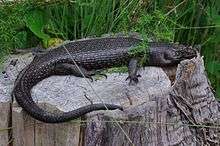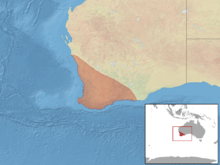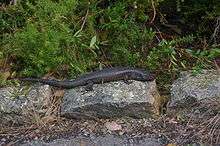King's skink
King's skink (Egernia kingii) is a species of skink, a lizard in the family Scincidae. The species is endemic to Australia.
| King's skink | |
|---|---|
 | |
| Albany, Western Australia | |
| Scientific classification | |
| Kingdom: | Animalia |
| Phylum: | Chordata |
| Class: | Reptilia |
| Order: | Squamata |
| Family: | Scincidae |
| Genus: | Egernia |
| Species: | E. kingii |
| Binomial name | |
| Egernia kingii (Gray, 1838) | |
 | |
| Synonyms[2] | |
| |
Etymology
The specific name, kingii, is in honor of Australian Phillip Parker King, who explored the coast of Australia while he was an officer in the Royal Navy.[3]
Geographic range
King's skink is native to coastal regions of south-western Australia.[4] It is common on Rottnest Island and Penguin Island and some coastal areas with open forest and open heath.
Description
King's skink is a large, heavy-bodied black skink that can reach a total length (including tail) of 55 centimetres (22 in)[4] with a mass of 220 grams (8 oz).
Diet
King's skink is omnivorous and consumes mostly softer plant matter from the range of local vegetation, but supplements its diet with insects and birds' eggs.[5]
History
A traditional name for King's skink is wandy, given by the Nyungar people of south-west Western Australia.[7] The first European to draw a King's skink was the artist and naturalist Ferdinand Bauer who made a detailed drawing of one during Flinders' expedition in 1801.[8]
Reproduction
Like many skinks, King's skink is viviparous, and after a gestation period of 20–22 weeks,[5] gives birth to litters of 2–8 young that have a typical mass of 7 grams (0.25 oz). Juvenile mortality is high and growth to adult size is slow, so mature King's skinks can be quite long lived.

References
- "Egernia kingii". IUCN Red List of Threatened Species. 2017: e.T178540A101749086. 2017. Retrieved 30 January 2020.
- Egernia kingii at the Reptarium.cz Reptile Database. Accessed 30 January 2020.
- Beolens, Bo; Watkins, Michael; Grayson, Michael (2011). The Eponym Dictionary of Reptiles. Baltimore: Johns Hopkins University Press. xiii + 296 pp. ISBN 978-1-4214-0135-5. (Egernia kingii, p. 141).
- "Waratah Software Natural Images of Australia". 2008. Retrieved 2008-05-03.
- Arena, P. C. & Wooller, R. D. (2008). "The reproduction and diet of Egernia kingii (Reptilia : Scincidae) on Penguin Island, Western Australia". Australian Journal of Zoology. 51 (5): 495–504. doi:10.1071/zo02040.
- Bradshaw, Don; Fabien, Aubret; Maumelat, Stéphanie; Schwaner, Terry & Bonnet, Xavier (2004). "Diet divergence, jaw size and scale counts in two neighbouring populations of tiger snakes (Notechis scutatus)". Amphibia-Reptilia. 25 (1): 9–17. doi:10.1163/156853804322992797.
- "Vocabulary collected by Isaac Scott Nind 1826-1829 at King George's Sound". 2008. Archived from the original on 2008-07-20. Retrieved 2008-05-03.
- "ABC - The Nauralists - Ferdinand Bauer". 2008. Archived from the original on 2008-04-17. Retrieved 2008-05-03.
Further reading
- Boulenger GA (1887). Catalogue of the Lizards in the British Museum (Natural History). Second Edition. Volume III. ... Scincidæ ... London: Trustees of the British Museum (Natural History). (Taylor and Francis, printers). xii + 575 pp. + Plates I-XL. (Egernia kingii, pp. 138–139).
- Glauert L (1960). "Herpetological miscellanea. XII. The family Scincidae in Western Australia. Part 1. The genera Tiliqua, Trachysaurus and Egernia ". Western Australian Naturalist 7 (3): 67-77.
- Gray JE (1838). "Catalogue of the Slender-tongued Saurians, with Descriptions of many new Genera and Species". Ann. Mag. Nat. Hist., First Series 2: 287-293. (Tiliqua kingii, new species, p. 290).
